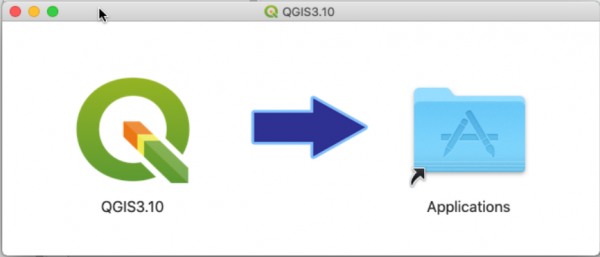QGIS installation
Contents |
Using your own laptop or PC
We prefer using Free and Open Source Software because this enables you to install software on your own computer without paying for costly licenses, to learn and continue your work at home. In this course we use the stable Version QGIS 3.10.5 'A Coruña' LTS (long-term support). QGIS is available on Windows, macOS, Linux and Android We recommend to use the QGIS Standalone Installer for Windows 64bit for this tutorial.
Installation Guide for Windows
- Do you have already a QGIS version installed? Please first deinstall previous QGIS versions before going on to avoid confusion.
 Uninstalling QGIS
Uninstalling QGIS
- To deinstall a QGIS version simply delete the installation folder, where the default paths are C:\OSGeo4W64, the user settings folder, downloaded plugins and user scripts C:\Users\YourName\AppData\Roaming\QGIS and related icons in the start menu and on the Desktop. Please check also if there is a "Standalone" QGIS version installed: Start --> Settings --> Apps & Features. Now a complete list of desktop programs is shown. Use the search box and type QGIS. If you do not find QGIS, a "Standalone" QGIS version is not installed. If you've find QGIS, single click its name to highlight it and hit the Uninstall button..
- Determine if your Windows is 32bit or 64bit Version. Knowing this information is important because you need to choose the right software so its performance can be optimized.
- If you are using Windows 8 or 10: On the Start Screen, press Win key (Windows logo key) and the x letter simultanously. Notice the menu of administrative tools in the lower-left corner of the screen, click System and view the information on system type.
- If you are using Windows 7: Press Win key (Windows logo key), Control panel --> System and Security --> System and view the information on system type.
- Download the OSGeo4W Network Installer 64bit for Windows 64-bit or the OSGeo4W Network Installer 32bit for Windows 32-bit and save the file into a temporary folder.
- Start the OSGeo4W Setup Program with a double click the on the downloaded file osgeo4w-setup-x86.exe.
- Choose Advanced Installation. Next.
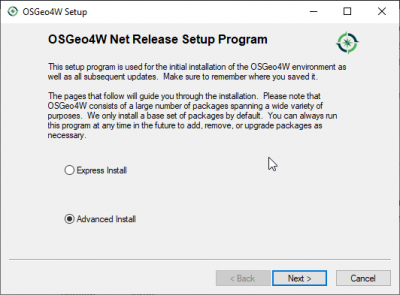
- Choose Install from Internet. Next.
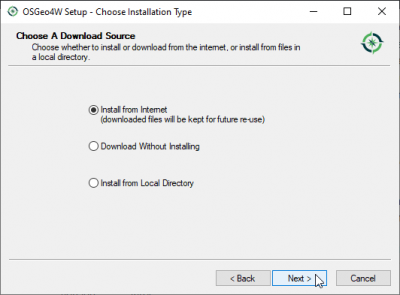
- Set root directory to: C:\OSGeo4W\ and check the radio button All Users. Next.
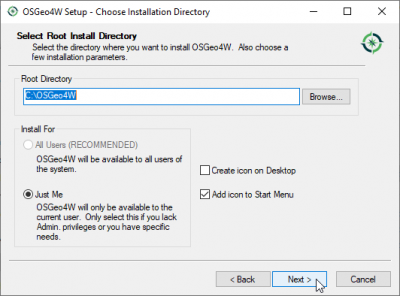
- Choose a temporary directory to store the files to be downloaded. Next.
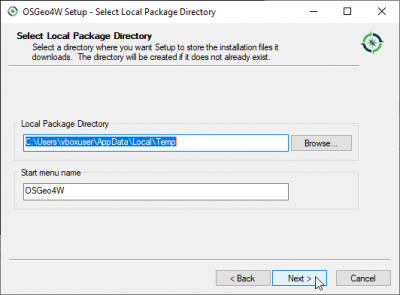
- Choose Internet connection: Direct connection. Next.
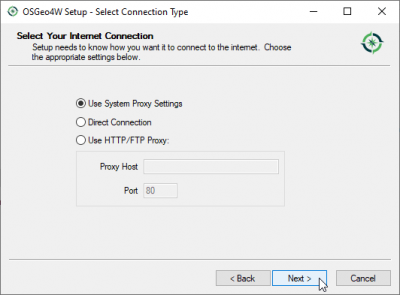
- Mark one of the download sites e.g. "http://osgeo4w-oslandia.com".
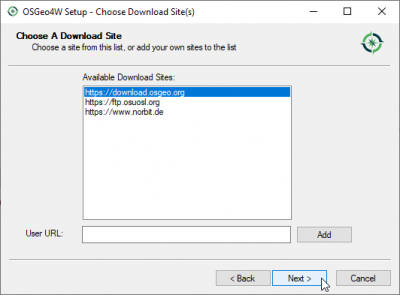
- Select Packages: In the "Categories field" click on the + symbol before "Desktop" to extend the folder. Click on the "Skip" symbol before qgis-full: QGIS Full Desktop (meta package for express install) to mark necessary software packages for the installation..
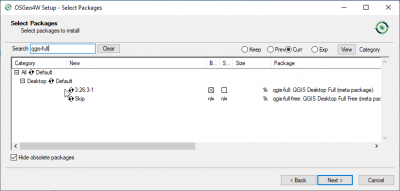
- Go on, accept the licence agreements and wait until all programs are installed.Next.
- Start QGIS by Start|All programs|OSGeo4W|QGIS Desktop.
 Updating QGIS
Updating QGIS
- Updating QGIS is easily done by using All Programs --> OSGeo4W --> Setup or by double clicking the file C:\OSGeo4W64\bin\osgeo4w-setup.exe. Follow the advanced installation procedure. New package versions will be automatically detected. Accept all previous settings and wait until all updated programs are installed.
Installation Guide for Mac OS 
- QGIS 3.10 is built for Mac OS versions High Sierra (10.13), Mojave (10.15), Catalina (10.15) and newer. On the QGIS download page are alo alternate installers available for older Mac OS and QGIS versions but the following instructions are easy as pie:
- If you have already an older QGIS version please uninstall this app first:
- Open Finder. In search bar type QGIS and Search: This Mac.
- Mark the QGIS icon. Right click: Move to Trash.
- Download QGIS macOS Installer Version 3.10. * Start the QGIS installer with a double click on the downloaded file qgis-amcos-pr.dmg.
- Click 'Agree' to accept the terms of license.
- Drag and drop the QGIS3.10 icon on the Applications icon.
- In Finder search in Applications for QGIS. Start QGIS with a double click on the icon.
Installation Guide for Linux 
If you are interested to try a Linux OS on your own Windows PC, we recommend to install the current distribution of Ubuntu. You can install Ubuntu onto a computer alongside a copy of Windows. You will be able to select whether to start Ubuntu or Windows each time your computer starts up or you can try to run Ubuntu on a CD or even on a memory stick alongside your current system.
Installation for Ubuntu 18.0.4 ("Bionic Beaver")
This tutorial is an example for the specific linux distribution Ubuntu LTS 18.0.4. If you want to use a different linux distribution or version read the docs on qgis.org and adjust reposiotry and code names for your selected distribution. To install latest release versions of QGIS, you have to add an alternative software repository. Please remove all previously installed QGIS und GRASS packages that were installed from other repositories before doing an update: otherwise conflicts between different package versions occur!
Open a terminal (Ctrl + Alt + t). Make a backup copy of your current sources.list file:
sudo cp /etc/apt/sources.list /etc/apt/sources.list.bat
Append new lines of text to current sources.list file
echo "deb https://qgis.org/debian bionic main" | sudo tee -a /etc/apt/sources.list echo "deb-src https://qgis.org/debian bionic main" | sudo tee -a /etc/apt/sources.list
Update in order to use the new repository and install QGIS and SAGA
sudo apt-get update sudo apt-get install qgis qgis-plugin-grass saga
In case of keyserver errors add the qgis.org repository public key to your apt keyring, type:
wget -O - https://qgis.org/downloads/qgis-2019.gpg.key | gpg --import gpg --fingerprint 51F523511C7028C3
Should output:
pub rsa4096 2019-08-08 [SCEA] [expires: 2020-08-08]
8D5A 5B20 3548 E500 4487 DD19 51F5 2351 1C70 28C3
uid [unknown] QGIS Archive Automatic Signing Key (2019) <qgis-developer@lists.osgeo.org>
After you have verified the fingerprint you can add the key to apt with:
gpg --export --armor 51F523511C7028C3 | sudo apt-key add -
Language settings
Go to Settings --> Options --> General and click the checkbox Override system locale on. You may choose one of 42 languages which are available for QGIS instead the system locale. For our course please select english (en_US). The settings are active after restarting QGIS.
